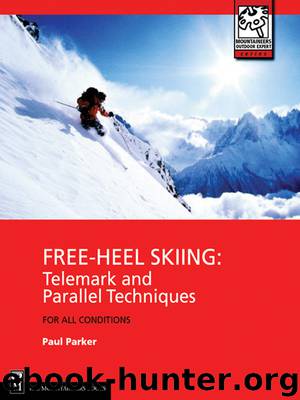Free-Heel Skiing by Paul Parker

Author:Paul Parker
Language: eng
Format: epub
Publisher: The Mountaineers Books
Scott Cramer
Training
I like to stay fit because I feel better. It makes skiing and summer activities more fun. For me, everyday exercise is a necessity, like eating and sleeping. That's the spirit of this chapter. We'll be talking about staying fit for better turns and for enjoyment of backcountry skiing–not competitive skiing. If you're competing, I'd recommend a qualified coach and a scientific training schedule to remain injury-free and to obtain your best results.
The best training for skiing is skiing, but we all don't have the luxury of skiing year-round. Besides, you need to participate in exercise other than skiing to develop the muscles that aren't so important to turns but that just might stave off fatigue and injury while skiing. And your head needs a break. It's great to enjoy the variety of other activities.
The first criterion for any kind of training is to choose a form of exercise that you enjoy enough to maintain. If you don't like it, you probably won't do it. Another criterion–one to be approached prudently–is specificity. If you have to make maximum use of a limited amount of training time, muscle- specific exercises will produce the greatest benefit. World-class coaches emphasize this training specificity to the extreme because they want their athletes to make the most of every training minute. The danger of being too specific is that it can be more like work. I try to choose an exercise first because it's fun, and second because it's applicable to skiing.
STRETCHING
First, always start with an easy warm-up before you stretch. This is crucial, since cold muscles aren't very elastic. Start easy to get your pulse up and your blood moving. Warm down in the same way, slowing to relax your muscles. Don't cool off too quickly.
Stretching before a workout is a great psyche-up and helps to prevent muscle injury. Read up on the subject, and establish a routine for major muscle groups. Bob Anderson's Stretching is a classic, an excellent primer. Be sensitive to your body: if a muscle or muscle group feels tight or fatigued, it could probably use some gentle stretching.
ORGANIZING AN EXERCISE SCHEDULE
The more you exercise, the more important it is to rest. Organize your schedule to include both hard and easy days for maximum benefit from your training. Alternate the hard and easy days, and take one complete rest day each week. Otherwise you will become tired and overtrained. You need to stay rested to get the most enjoyment from each workout.
How long should you exercise each day? You don't have to maintain a rigid schedule to get plenty of positive benefit from training, but some guidelines are helpful. These days coaches acknowledge that quality is more important than quantity. Using a “normal” week as an example, I exercise about an hour each workday, reserve a long, easy workout for Saturday (2 to 3 hours), and save a long, hard workout for Sunday (1Vi to 2 V2 hours). Monday is for resting. Climbing or skiing over the weekend counts toward the long workout–that's what I'm training for.
Download
This site does not store any files on its server. We only index and link to content provided by other sites. Please contact the content providers to delete copyright contents if any and email us, we'll remove relevant links or contents immediately.
A Wilder Time by William E. Glassley(2789)
Erebus by Michael Palin(1761)
Arctic Dreams by Barry Lopez(1697)
Winter Calling by Lynn Galli(1598)
The Art of Fear by Kristen Ulmer(1497)
South with the Sun by Lynne Cox(1490)
Mawson's Will by Lennard Bickel(1382)
Caroline Alexander by The Endurance: Shackleton's Legendary Antarctic Expedition(1320)
Big Dead Place: Inside the Strange and Menacing World of Antarctica (Large Print 16pt) by Nicholas Johnson(1318)
Total Hockey Training by Sean Skahan(1305)
South by Ernest Henry Shackleton(1293)
Bugaboo Dreams by Topher Donahue(1281)
Training Season (E) (MM) by Leta Blake(1273)
Zoo Tails by Oliver Graham Jones(1250)
Panama by Lonely planet(1224)
Ice! by Tristan Jones(1179)
Ice by Unknown(1174)
Lonely Planet Panama by Lonely Planet(1130)
Frozen in Time by John Geiger & John Geiger(1121)
